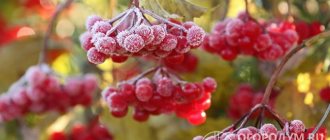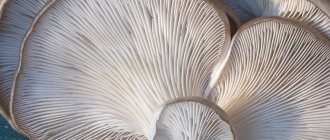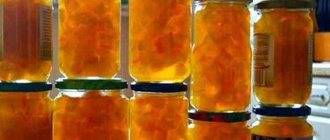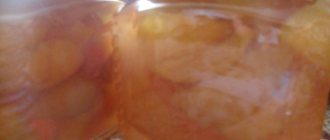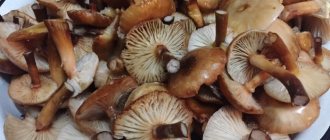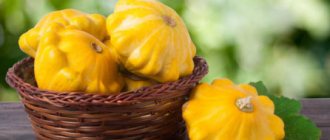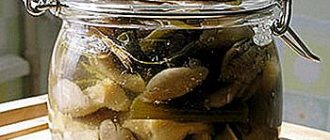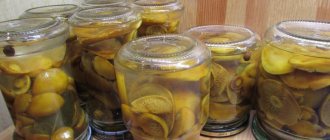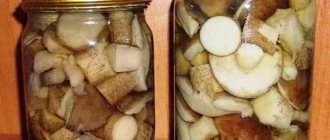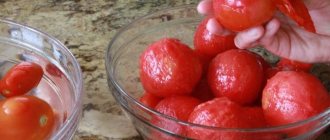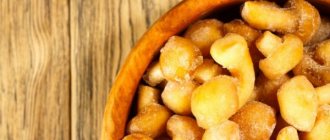Honey mushrooms or honey mushrooms are widespread throughout Russia and enjoy the well-deserved love of mushroom pickers. According to the growing season, honey mushrooms are divided into summer, winter and autumn. The most suitable for harvesting are varieties whose mass harvest occurs from August to November. Not only can they be salted, but autumn honey mushrooms (Armillariella mellea) are very good when pickled and are suitable for drying. They are included in a limited number of agaric mushrooms that are allowed, according to federal sanitary rules, for drying and harvesting along with chanterelles and cultivated champignons.
Salting and marinating are different processes. Read about methods for pickling honey mushrooms in this article.
Salted honey mushrooms are rightfully considered one of the best cold appetizers in traditional Russian cuisine.
Honey mushrooms are not a specific type of mushroom, but a whole group of 5 different genera belonging to 3 families. The general name was given to them for their “habit” of growing on stumps, as well as large roots protruding from the ground, and even the trunks of old trees (the only exception is the meadow honey fungus, also known as the non-rotting mushroom). Almost all varieties of honey mushrooms are distinguished by the fact that they are placed in heaps, in numerous fused groups consisting of small mushrooms of varying degrees of maturity. They do not have to be collected individually, so if you can find at least one mushroom spot, you can quickly fill baskets and buckets with a bountiful harvest.
Honey mushrooms (pictured) grow together in large families, which greatly simplifies the mushroom harvest in the forest
Most representatives of the group of mushrooms belong to conditionally edible species, and in terms of nutritional value - to categories 3-4, therefore, before cooking, pickling or pickling, it is recommended to first boil them for at least 20-30 minutes. Some varieties are distinguished by unusual shades of aroma, such as garlic (garlic honey fungus) or cloves (meadow mushroom).
Beginning mushroom pickers should be extremely careful when collecting autumn mushrooms, as they can easily be confused with the poisonous brick-red and sulfur-yellow honey mushrooms of the genus Hypholoma sublateritium. And the inedible common flake (Pholiota squarrosa) and the extremely poisonous galerina marginata (Galerina marginata) are very similar in appearance to their summer edible “brothers”.
It is quite problematic to distinguish a real honey mushroom from a false one (not every specialist can do it), so it is better not to touch questionable mushrooms at all, and certainly not to use them for food. Here are the main signs to help guide you:
| Sign | Autumn honey fungus | False foam |
| Ring on the leg | The stem has a “skirt” or “cuff” - a membranous ring (the remnant of the shell that protects the fruiting body of the fungus at the initial stage of growth) | Ring fibrous, pressed |
| Cap color | Light brown (ocher) – dim | Significantly brighter: grayish yellow to brick |
| Presence of scales | On the cap (especially in young mushrooms) and in the lower part of the stem (slight) | There are no scales on the cap, its surface is smooth |
| Records | White or yellowish, with small brownish spots | Olive or greenish-black with a brown tint |
| Flesh color | White | Yellowish |
| Smell | Weak mushroom | Unpleasant earthy |
| Taste | Soft | Bitter |
You can learn how real honey mushrooms are collected in the autumn forest, as well as their beneficial properties, from the following video:
We will assume that we have dealt with the theoretical part and can move on to the main topic of the article, namely: the aspects of preparation, methods, technologies and recipes for preparing salted honey mushrooms.
Hot pickling recipe
- 1 kg honey mushrooms;
- 4-5 tbsp. l. salt;
- spices to taste (pepper, bay leaf, currant and cherry leaves, garlic, etc.)
What to do next:
- The first step is to sort out the mushrooms, clearing them of forest debris. Usually honey mushrooms are small in size, so it is much easier to wash them if you first soak them in cold water for an hour and move them a little in the water with your hands every 15-20 minutes.
- After about an hour, you will notice how the mushrooms have lightened; use a spoon to place them in a colander, being careful not to stir up the layer of dirt that has settled to the bottom.
- Rinse the mushrooms directly in a colander under running water, transfer to an enamel pan and cover with cold salted water.
- Cook after boiling for about 20 minutes, until they begin to sink to the bottom. In this case, it is necessary to remove any foam that appears.
- Place the boiled mushrooms in a colander again and stir lightly with a spoon to drain all the liquid.
- Place leaves and spices on the bottom of a glass or ceramic bowl, and on top - a layer of hot boiled honey mushrooms, spices again on them, and so on.
- Cover the bowl with an inverted plate, put some weight on top, for example, put a jar filled with water.
- You can leave the bowl with the preparation on the table or put it in the refrigerator.
- After some time, the mushrooms will release juice, and the surface will be covered with a thin layer resembling mold - this will be a sign that the mushrooms are ready for use.
The appetizer is prepared in a bowl on the table for about a week, in the cold for about a month.
Preparing mushrooms
Having harvested the honey mushrooms, you must immediately begin processing before they choke, break, stick together or become spoiled by worms.
Small mushrooms are considered ideal for home and industrial preservation, since whole mushrooms, while maintaining their natural appearance, look very attractive and appetizing
First of all, the mushrooms are separated by cutting off the lower fused part of the stems and sorted, discarding overripe, wormy, dried or broken ones. Immediately get rid of large plant debris - leaves and grass. For preparations for the winter, honey mushrooms do not need to be sorted, since they do not grow to too large a size, but in adult mushrooms it is recommended to separate the stems, cut them lengthwise (“noodles”), and the caps into 2-4 parts. Young small mushrooms are used entirely.
Cleaning each mushroom by hand is not about mushrooms! In order to remove the remaining soil and sand from them, soak them in water. Some mushroom pickers pour cold water over honey mushrooms for 2-3 hours, changing the water several times until it becomes clean. Others advise to speed up the process of cleaning mushrooms by taking hot water and adding salt to it. This is done as follows:
When soaking and washing, the mushrooms are further examined, removing the remaining waste, and then placed in portions in a colander and left for a while to allow excess water to drain.
How to pickle honey mushrooms for the winter in jars
Mushrooms pickled in a bowl, after they have been salted and given juice, can be placed in glass jars, covered with plastic lids and placed in the refrigerator.
It should be remembered that salted mushrooms may form a substance that causes botulism during storage. Symptoms of botulism are similar to those of poisoning, so it is not recommended to seal jars with metal lids.
If the lid is swollen and the contents are cloudy, such preparations should not be eaten.
In those places where there are a lot of honey mushrooms, there is a very simple method of pickling.
- After washing, the mushrooms should be boiled in heavily salted water for at least 20 minutes.
- Hot honey mushrooms along with brine are poured into clean glass jars, which are immediately closed. The more salty the water, the better they will be stored.
- Before use, be sure to soak to remove excess salt.
A simple recipe for salted honey mushrooms without vinegar
According to this recipe, mushrooms are salted without adding vinegar and are not boiled. They stand long enough for them to fully cook. They turn out tasty and have a characteristic woody taste, which gives them a tartness.
